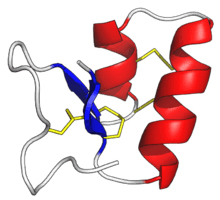Thionin
Thionins (without an e) are a family of small proteins found solely in higher plants. Typically, a thionin consists of 45–48 amino acid residues. 6–8 of these are cysteine forming 3–4 disulfide bonds. Alpha- and beta- thionins are related to each other. The gamma thionins have a superficially similar structure but are an unrelated class of protein, now called plant defensins.
| Plant thionin | |||||||||||
|---|---|---|---|---|---|---|---|---|---|---|---|
 | |||||||||||
| Identifiers | |||||||||||
| Symbol | Thionin | ||||||||||
| Pfam | PF00321 | ||||||||||
| InterPro | IPR001010 | ||||||||||
| PROSITE | PDOC00244 | ||||||||||
| SCOPe | 1cnb / SUPFAM | ||||||||||
| TCDB | 1.C.44 | ||||||||||
| OPM superfamily | 140 | ||||||||||
| OPM protein | 2plh | ||||||||||
| |||||||||||
Activity
The proteins are toxic to animal cells, presumably attacking the cell membrane and rendering it permeable: this results in the inhibition of sugar uptake and allows potassium and phosphate ions, proteins, and nucleotides to leak from cells.[1] Thionins are mainly found in seeds where they may act as a defence against consumption by animals. A barley (Hordeum vulgare) leaf thionin that is highly toxic to plant pathogens and is involved in the mechanism of plant defence against microbial infections has also been identified.[2] The hydrophobic protein crambin from the Abyssinian kale (Crambe abyssinica) is also a member of the thionin family.[1] Some thionins have cytotoxic activity and they are therefore interesting in the development of new drugs against cancer with novel action mechanisms.[3] No thionin has yet been developed into an anti-cancer drug. Thionin is also a minor protein found in mustard (Brassica napus L.) seeds.[4]
Databases
A database for antimicrobial peptides, including thionins is available: PhytAMP.[5]
See also
- Crambins
- Gamma thionins
- Antimicrobial peptides
References
- Vernon LP, Evett GE, Zeikus RD, Gray WR (1985). "A toxic thionin from Pyrularia pubera: purification, properties, and amino acid sequence". Arch. Biochem. Biophys. 238 (1): 18–29. doi:10.1016/0003-9861(85)90136-5. PMID 3985614.
- Apel K, Andresen I, Becker W, Schluter K, Burges J, Parthier B (1992). "The identification of leaf thionin as one of the main jasmonate-induced proteins of barley (Hordeum vulgare)". Plant Mol. Biol. 19 (2): 193–204. doi:10.1007/BF00027341. PMID 1377959.
- Florack DE, Stiekema WJ (October 1994). "Thionins: properties, possible biological roles and mechanisms of action". Plant Mol. Biol. 26 (1): 25–37. doi:10.1007/BF00039517. PMID 7948874.
- Bérot S; Compoint JP; Larré C; Malabat C; Guéguen J. (2005). "Large scale purification of rapeseed proteins (Brassica napus L.)". Journal of Chromatography B. 818: 35–42. doi:10.1016/j.jchromb.2004.08.001.
- "PhytAMP Database".; Hammami R, Ben Hamida J, Vergoten G, Fliss I (January 2009). "PhytAMP: a database dedicated to antimicrobial plant peptides". Nucleic Acids Res. 37 (Database issue): D963–8. doi:10.1093/nar/gkn655. PMC 2686510. PMID 18836196.